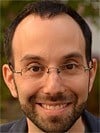Hundreds of young Mayan students gathered with their teachers and a small group of New York Jews, standing in a wide circle as we observed an astonishing spectacle. Rivulets of bubbling candle wax streamed onto the ground. Flowers withered and crumpled in smoke and flames. A priest of the Maya Achi tradition presided over the enormous, smoldering sacrifice of candles, flowers and grains which he had spent hours laying out on the ground in traditional colors: red, black, white and yellow for the four directions of the compass; blue and green in the center for the sky and the earth.
The New Hope Community Bilingual Institute,[1] outside Rabinal, Guatemala, had arranged the priest’s demonstration as part of its mission to “renew, revalue and recuperate” the traditional Maya Achi culture, just over 10 years after its devastation by violence in the Guatemalan civil war.[2] As the priest raised a conch shell and sounded it to the four winds, the Mayan students, a generation unfamiliar with these rituals, stared in fascination. I imagined them wondering: What’s the purpose of all this? Why are we being asked to take this seriously?
The same questions are raised for us by Parshat Tzav, with its elaborate rituals for ordaining the first Jewish priests, the kohanim. Aaron and his sons are dressed in strange garments. Oil is poured on their heads. Three kinds of bread are sandwiched with a bloody ram’s thigh and waved in the air. Blood is dashed and smeared on the horns of an altar and on the tips of the priests’ right ears, the thumbs of their right hands and the big toes of their right feet.
Despite the foreignness of these rituals to us contemporary Jews and to the Mayan students, the Guatemalan government well understood their power. In fact, Mayan priests were deliberately targeted for murder during the war in Guatemala, when the state sought to eradicate rebel guerrillas and the indigenous population that was believed to support them. As the country’s Commission for Historical Clarification later reported:
The Army destroyed ceremonial centres, sacred places and cultural symbols. Language and dress, as well as other elements of cultural identification, were targets of repression[.] … [T]he exercise of Mayan spirituality and the Catholic religion was obstructed, prevented or repressed[.][3]
What was so threatening about the Mayan priests and their religion? A clue appears in the second-to-last verse of our parshah, as Moses concludes his instructions to the newly invested kohanim: “You shall remain at the entrance of the Tent of Meeting… keeping the Lord’s charge—that you may not die[.]”[4] This odd phrase, “keeping the Lord’s charge—ushmartem et mishmeret Adonai,” literally, “keep the guard-shifts of the Lord,” points to the priests’ vital role in consistently maintaining the rituals of the Temple. They must “remain” in their place; they must “keep” the role assigned them by God. That they might die for failing to do so demonstrates that the priesthood is essential to life, to existence.
The Guatemalan army clearly understood that the Mayan religion was similarly linked to the indigenous people’s survival. Indeed, the Guatemalan truth commission concluded that as a result of targeting the Mayan communities’ spiritual leadership, the Guatemalan army disrupted “the maintenance and development of the indigenous peoples’ way of life and their system of social organisation…”[5] This case shows that in the absence of regular ritual practice, not only may the priests die, as Parshat Tzav warns, but also the people itself cannot live on.
The early Rabbis found a second level of meaning in the priestly mandate, focusing on the second half of the phrase—“the Lord’s charge”—that is, that of God and not of humans. They wrote: “Just as one who fulfills the words of [an authority] of flesh and blood is acceptable before God, all the more so is one who fulfills the words of God.”[6] In other words, the role of the priests is to look beyond human authority and adhere to the sovereignty of the Creator of all, the Sovereign of sovereigns. This refusal to acknowledge the ultimate authority of human rulers is exactly what makes priests, like all genuine religious leaders and like religion itself, potentially so threatening to any totalitarian regime.
Today, when the avodah, the service of the Temple, has been replaced by prayers and other ritual practices, all of us have a share in the priestly role. We too are obligated to “keep the Lord’s charge,” in both senses: to pursue our ritual practices persistently, and to challenge human authorities decisively when they are illegitimate and oppressive. In doing so, we seek to ensure that the Jewish people—as well as other peoples and traditions—do not die but thrive and evolve, in order to bring more Divinity and justice to our diverse, tumultuous, strange and fascinating world.
[1] The school, serving rural children in grades 7-9, is a project of Fundación Nueva Esperanza, an AJWS grantee. I visited in 2008 with AJWS and Congregation B’nai Jeshurun (NYC). http://www.fne.cosmosmaya.info/nuestro_instituto_en.html
[2] The Guatemalan Civil War, 1960-1996, was characterized (esp. 1980-1983) by massive state-sponsored violence against indigenous Mayan civilian communities, leading many observers to call it a genocide rather than a civil war.
[3] Guatemala: Memory of Silence. Report of the Commission for Historical Clarification (CHC), 1999, Conclusions, Sec. 2. http://shr.aaas.org/guatemala/ceh/report/english/conc2.html
[4] Leviticus 8:35.
[5] Ibid, CHC, above.
[6] Torat Kohanim (Sifra) Tzav, Mechilta D’Miluim 1:38 (ca. 3rd c.).

